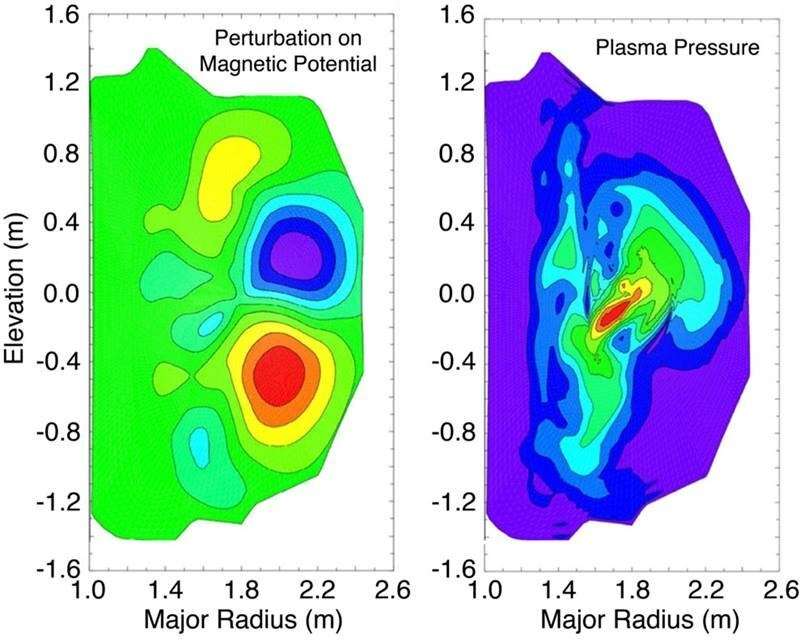This article has been reviewed according to Science X's editorial process and policies. Editors have highlighted the following attributes while ensuring the content's credibility:
fact-checked
peer-reviewed publication
trusted source
proofread
Resistance in tokamak vessel walls can cause disruptive energy loss

Under certain conditions, the fusion devices known as tokamaks can suffer a sudden loss of energy to the vessel walls. Researchers call this energy loss process a disruption. One cause is a magnetohydrodynamic (i.e., conducting plasma in a magnetic field) instability, or mode, coupling to the vacuum vessel.
New research demonstrates that the rate of thermal energy loss is consistent with the growth of a particular instability, the resistive wall tearing mode (RWTM). Experimental measurements show that the plasma temperature decays on a timescale consistent with the mode growth. Simulations show that the RWTM would be stable in the presence of a perfectly conducting wall, and also that the unstable mode grows to sufficient amplitude to cause the rapid loss of plasma energy. This rapid energy loss is termed the thermal quench. The simulated amplitude and onset condition agree with experimental results.
The goal of developing fusion power is driving researchers to develop experiments for the ITER tokamak. Currently under construction, ITER will be the world's largest and most powerful tokamak once completed. This research informs how quickly thermal quenches may happen in ITER. This will affect how operators mitigate these disruptions. Uncontrolled disruption events in a large machine like ITER can cause significant damage to the vessel and need to be avoided.
Simulations of a standard ITER reference scenario predict that the plasma will be unstable to RWTMs. If thermal quenches are driven by RWTMs as observed and modeled in existing devices, then the thermal quench in ITER will be much longer than originally expected. This information can help operators modify ITER's disruption mitigation system, thereby reducing associated risks.
In tokamak disruptions, plasma energy is rapidly transported to the device walls. The time duration of this thermal quench process sets the requirements for any mitigation techniques that might be applied. In recently published research in Physics of Plasmas from HRS Fusion and the DIII-D National Fusion Facility, a Department of Energy user facility, scientists detailed a physics-based understanding of this process by combining experiments, simulations, and theory to study the evolution of plasma instabilities during a disruption.
Simulations demonstrate both that the scaling of the instability growth rate is consistent with expectations based on vessel conductivity, and that the thermal quench time is proportional to the linear growth time. The simulated growth rate and amplitude of the RWTM agrees with the timescale of the thermal quench in the experiment. Extending this result—from the DIII-D tokamak, where the thermal quench is typically a few milliseconds, to ITER—suggests that the thermal quench duration in ITER could be on the order of 70-100 milliseconds. Importantly, this work provides a physics basis for determining the relevant timescale in ITER, and a longer duration thermal quench reduces engineering constraints on various disruption mitigation techniques.
More information: H. R. Strauss et al, Resistive wall tearing mode disruptions in DIII-D and ITER tokamaks, Physics of Plasmas (2022). DOI: 10.1063/5.0107048
H. Strauss et al, Effect of resistive wall on thermal quench in JET disruptions, Physics of Plasmas (2021). DOI: 10.1063/5.0038592
H. Strauss, Thermal quench in ITER locked mode disruptions, Physics of Plasmas (2021). DOI: 10.1063/5.0052795
Journal information: Physics of Plasmas
Provided by US Department of Energy





















